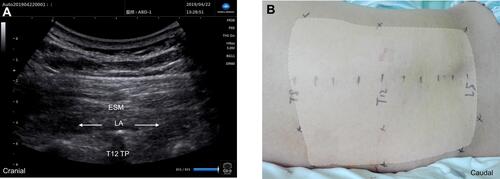Figures & data
Figure 1 The Consolidated Standards of Reporting Trials (CONSORT) flow diagram of the study. ESPB, erector spinae plane block.

Figure 2 Longitudinal parasagittal ultrasound view (A) and extent of cutaneous sensory loss over the back at 40 minutes after the injection of 25 mL of 0.3% ropivacaine in one patient at the T12 level (B). Arrows represent the spread of local anesthetic. TP, transverse process; ESM, erector spinae muscle; LA, local anesthetic.

Table 1 Baseline Demographic and Clinical Characteristics of Study Participants
Figure 3 (A) The primary outcome of the MOAA/S score was assessed every 10 minutes, from 10 to 30 minutes after extubation in patients receiving T12 ESPB (orange) or no block (grey) undergoing posterior lumbar surgery. (B) The postoperative cumulative morphine consumption (mg) at 24 and 48 hours in patients receiving T12 ESPB (orange) or no block (grey). (A) n = 30 for all groups; (B) n = 28 for all groups. Repeated measures two-way ANOVA + Bonferroni. *P < 0.05. Data are presented as mean (SD).
Abbreviations: MOAA/S, Modified Observer’s Assessment of Alertness/Sedation; ERAS, enhanced recovery after surgery; ESPB, erector spinae plane block; MOAA/S, Modified Observer’s Assessment of Alertness/Sedation; ASA, American Society of Anesthesiologists; NRS, numerical rating scale; MAP, mean arterial pressure; PACU, post-anesthesia care unit; PCIA, patient-controlled intravenous analgesia; TP, transverse process; ESM, erector spinae muscle; LA, local anesthetic.

Table 2 Intraoperative Outcomes
Table 3 Follow-Up Outcomes
